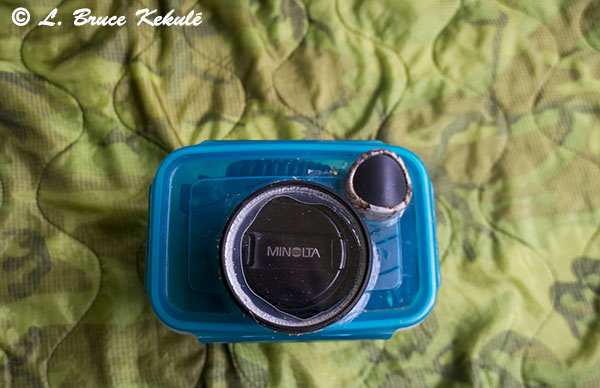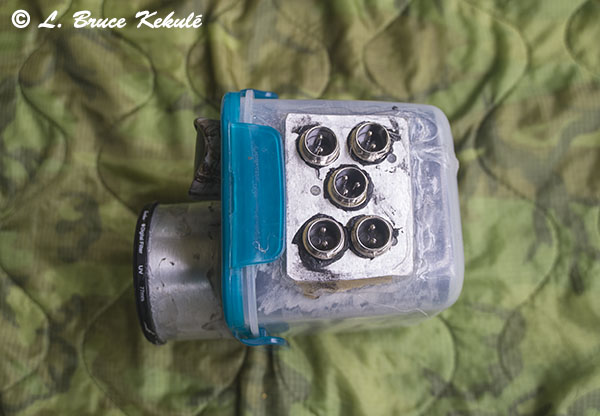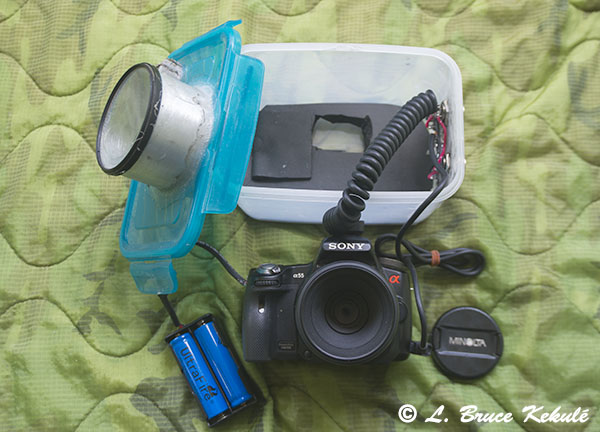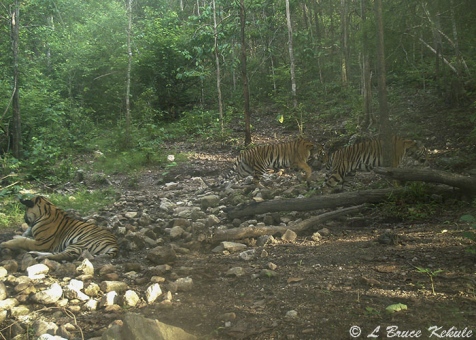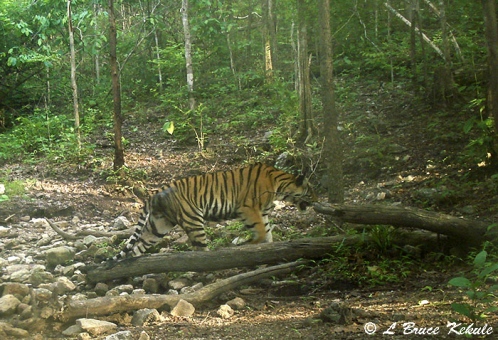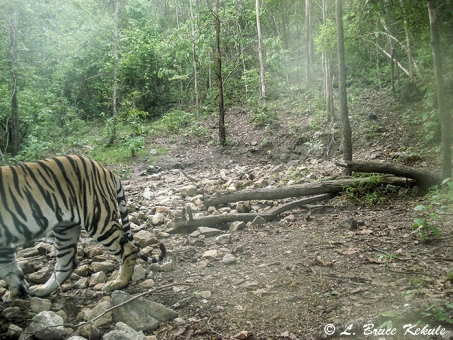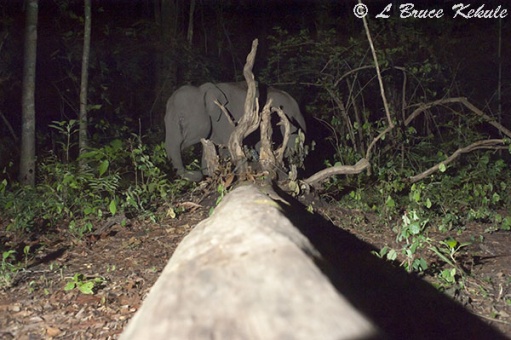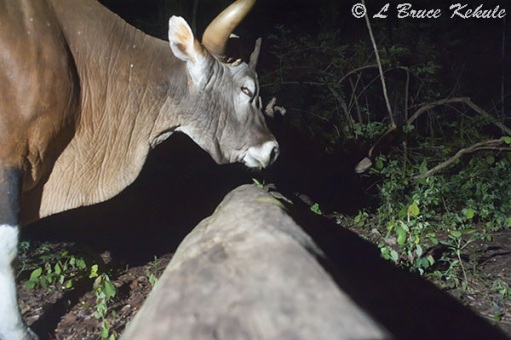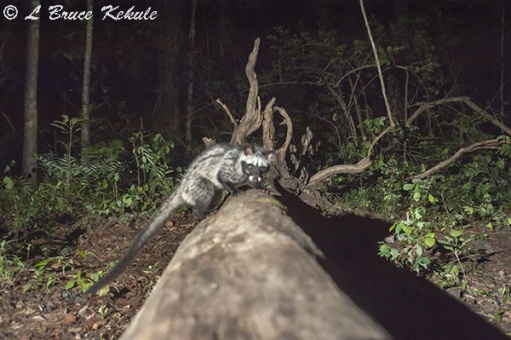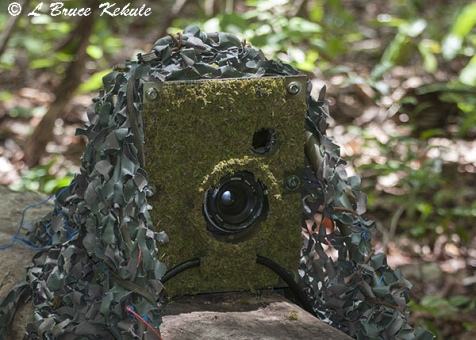Posts Tagged ‘homebrew trail cam’
My smallest DSLR camera trap…!
A ‘Hybrid’ trail cam – Sony A55 DSLR/Minolta 50mm macro lens
Sony A55 DSLR – Minolta 50mm Macro lens.
DSLR trail cameras for the most part are pretty big. Camera-trappers have built them mostly using the Pelican 1200 and even the 1300 case, and other makes like Plano and Seahorse large cases have also been used.
I have built a few now and like the smaller Pelican 1150 for my Nikon D700 and D300s plus a Canon 400D and 600D with 8-volt SLA battery packs, and even a smaller Pelican 1120 for a Sony A500 but they are still pretty big and standout sitting on a tree in the forest.
Top view of a Sony A55/Minolta 50mm in a ‘Tupperware’ type box.
In my case, elephant’s will home in on strange objects and strength plus rigidity is the No: 1 priority. With my ‘elephant proof’ boxes and three to four lag bolts, these hard and sharp edged external aluminum boxes have survived the forest giant stomping test many times…!
But I wanted something smaller. After some sole searching, I found this lockable plastic box (a Tupperware type) that would allow a small Sony A55 DSLR to just sit in the box with a Minolta 50mm ‘macro’ lens (just happen to have this lens from my old days when I used Minolta cameras). A pair of 18650 Lithium 4.2 volts for externals is used. The A55 is a 12 megabyte camera and is perfect for a camera trap.
Side view showing connections for flashes (two-pin) and sensor (three-pin).
The Minolta lens works in the Sony perfectly. The snorkel is a length of 77mm diameter thin aluminum tubing secured to the box with Goop. I prefer this to the large, thick and heavy PVC tubing. Goop is also used to attach a 77mm UV filter to the snorkel.
A dedicated ‘elephant proof’ box was built to house the fragile plastic box and camera. I have incorporated a cover to protect the wires and plugs from probing elephant trunks. Four stainless steel lag bolts and a 10mm Python cable secure the box to a tree.
Sony A55/Minolta 50mm showing 18650 4.2-volt externals.
As I won’t be using the flip-up flash or a dedicated hot-shoe flash, I’m using a TTL head and hard-wire everything using two-terminal quick-disconnect plugs for the flashes. A three-terminal plug is used for the sensor, and I seal the plugs with 3M-silicon sealant as shown in the photos. I’ve installed a thin aluminum plate to beef-up this area.
Three flashes are on 10-meter lengths of two-conductor shielded wire with gland fittings on the flash boxes. The fourth flash is on a 15-meter wire to be placed across from the cam hoping to get backlighting of some sort (the set-up and location will require experimentation). I’m using three SB-28s and one SB-80 Nikon flash. All flashes are in ‘Tupperware’ type boxes with elephant proof shrouds made up.
Sony A55 with hard-wired Nikon flashes and SSII hard-wired sensor.
The sensor is a Snapshotsniper SSII with a #5 chip, also on a 10-meter hard-wire cable to be installed on a trail about 6-8 meters from the cam. This way I can focus precisely at the sensor.
I have the perfect place for this cam…to replace the Sony P41 that has captured tiger and leopard plus many other creatures. I will be setting it up in a few days. The rainy season has started and there are not many people around in this area. I’m hoping for some dramatic shots of a black leopard and the other cryptic animals that pass by.
Sony A55 trail cam and ‘elephant proof’ box.
A Sony P41 post with tiger and black leopard to follow…!
TIGER AND BANTENG – Sony W30 set
Tiger mother and two full grown cubs.
Recently, I pulled a Sony W30 camera trap from a mineral deposit in the Western Forest Complex and found some amazing photos of a mother tiger and her two cubs. It is very rare to see a tiger family on a trail cam. These amazing creatures usually do not hang around when it starts flashing at them…but I got some great shots shown here.
Mother and cub.
The two cubs leaving the mineral deposit.
Mother on the way out.
Another tiger visits the camera.
Banteng have now become quite rare in Southeast Asia but thrive in two wildlife sanctuaries in Thailand; one in the east and one in the west. Here are some shots of these beautiful wild cattle. The old bull looks like he is having a heck of time with the moths.
Banteng herd at the mineral deposit.
Old banteng bull and moths after a big rain.
Nikon D700 trail cam: The first set
Elephant, banteng, civet and bat captured
Wild elephant; not sure why the cam tripped with the jumbo on the far side of the sensor??
Went into Huai Kha Khaeng to check my D700 trail cam a couple of days ago….the weather was horrible with a big storm brewing and rain had already started to fall. I had to get in and get out.
The young elephant headed for the cam; and it tripped again.
Instead of topping up the card, batteries and desiccant, I decided to pull the unit and two flashes that were not working. One Nikon SB28 flash was still OK and I left it.
A powerful trunk that tried to move the cam but could not budge it.
After downloading the card, I got a pleasant surprise that the D700 had performed quite well on its first stint. Elephant, banteng, a civet plus a bat had tripped the cam.
This elephant ripped most of the camouflage netting off the cam.
There were some strange false triggers but I guess with bats or birds that fly through, the unit will trip to an empty frame. I was elated to say the least.
A mature banteng bull.
I will go back in a week and will move the D700 about two-three feet closer as there is too much log in the frame and the composition is still not right.
This bull looks like he is blind in the right eye.
The elephants ripped most of the camouflage netting off the cam but it survived intact and was still as solid as the log meaning they could not budge it. The moss was OK.
A bat flying through.
Needless to say, I look forward to more sets from this cam. I will be adding another flash to the right side of the log to get rid of the shadow. It is just a matter of time before a tiger or leopard jumps this log.
A common palm civet posing on the log.
Unfortunately, the civet was just inside the focal plane and therefore not in focus. But they are so common here, I’m positive I will get this critter again…! Enjoy.
The Nikon D7oo trail cam on a fallen tree.


